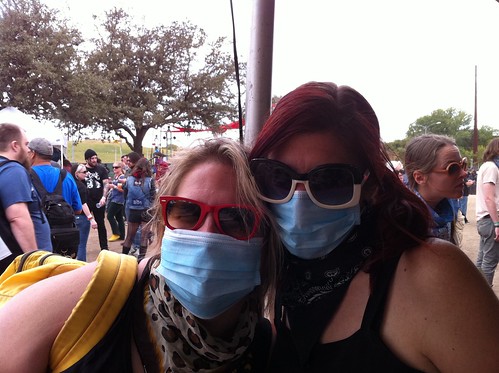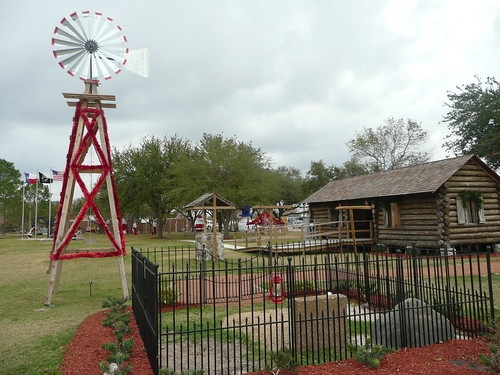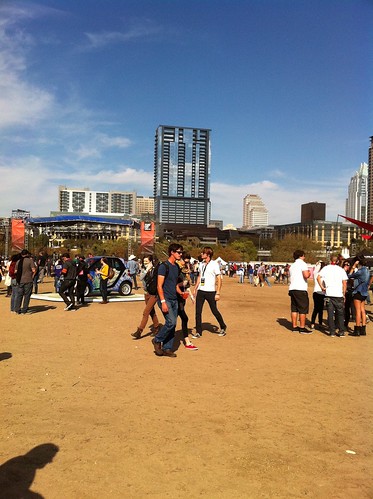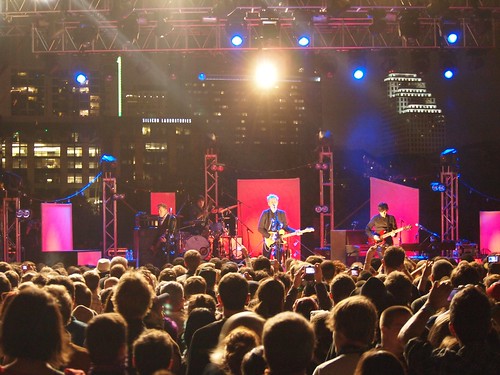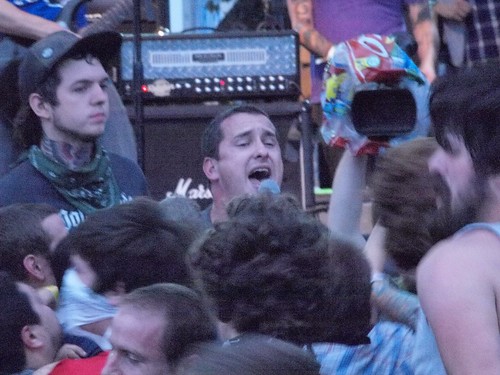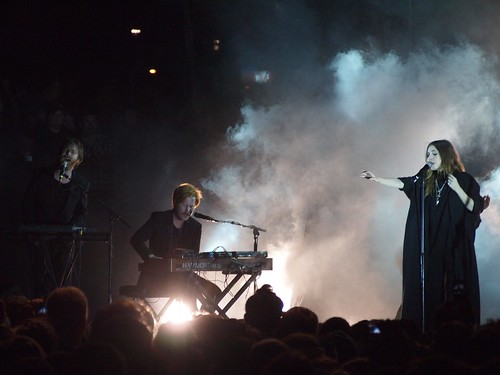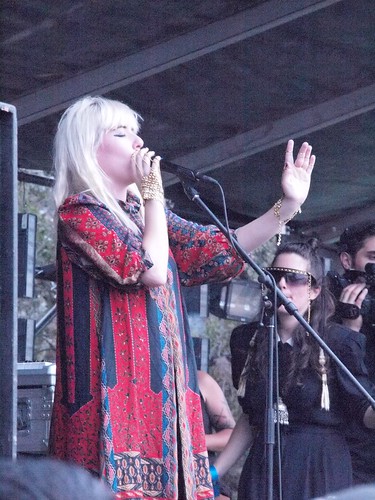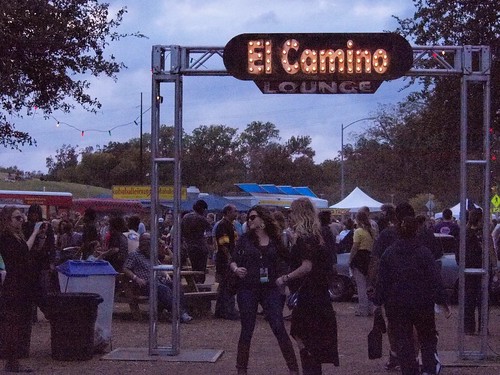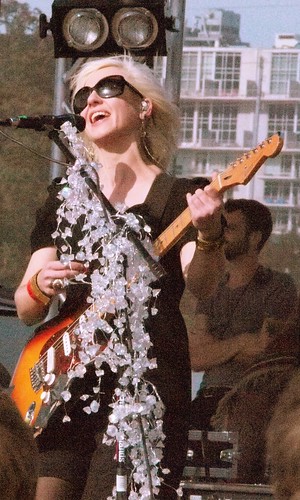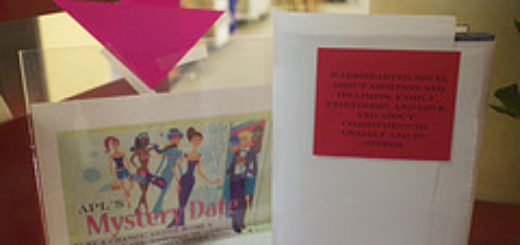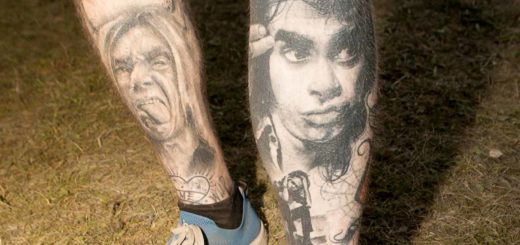Why I Spend So Much Time Going to Shows, Listening to Music
Thousands of people from all over the world gather in Austin, Texas each March for the South By Southwest Music Conference and Festival. They come back for Austin Psych Fest in the late spring, Chaos in Tejas in the early summer, Austin City Limits Music Festival in the early fall and Fun Fun Fun Fest in the late fall. When the music tourists are here, they crowd into the clubs that I help keep open the rest of the year.
This is why I do that.
Me and my friend Deb, Fun Fun Fun Fest, 2011. I’m in the red sunglasses.
By Anna Hanks
—–
Living in Austin I don’t usually feel that old. Going to yoga, or the grocery store, I blend into the crowd—although I may be a touch too old to be popping into the dry cleaners with a hoodie from The National zipped over my battered Death Cab For Cutie tee.
Despite fitting squarely within the population curve of Austin –where the majority of the population is between 20 and 44 years old– that sometimes doesn’t matter when I go out at night. Over the last few years I’ve gotten used to being older—sometimes decades older—than other people in the crowd when I go to see a band in Austin.
When my grey-haired husband and I saw the hot DJ Skrillex at the 2011 Austin City Limits Music Festival, I realized I had a good 20 years on nearly everyone in the underage crowd. During the show, I realized that my car—and some of my concert shirts— were older than nearly everyone else dancing manically to Skrillex’s hits.
Something is very odd in my musical life, and it took becoming an indie-pop Sherpa guide for one of my oldest friends at a dusty indie pop/punk festival in Austin to make it clear how far my tastes have moved from most other people my age.
My past isn’t typical:
Ye Olde version of downtown Deer Park, Texas.
I grew up in the conservative small town of Deer Park, Texas in the 1970s and 80s. It’s a smallish working-class suburb of Houston located near the Houston Ship Channel. The city limits include many of the petrochemical refineries producing products Americans use every day. While I didn’t know him due to school boundary lines, it’s also the hometown of onetime Yankees pitcher Andy Pettitte, who also played for the Houston Astros.
It’s a world away from Hollywood, but it was the setting for the 1980 movie Urban Cowboy. That movie was mostly set in the local western bar Gilley’s, whose mechanical-bull co-starred with John Travolta in the film.
Typical for Texas, my family is conservative, teetotaling Baptist, Republican and very traditional. (I never set foot in Gilley’s before it burned down.) My family bookshelf included paperbacks from the ultra-conservative John Birch Society as well as multiple copies of the Bible. At an early age, I was taught not to touch the well-stocked and locked gun cabinet with a peeling NRA sticker.
I grew up in the 70s, but it was not a hippie childhood. I missed summer camp, but I went to a lot of Vacation Bible School. As a child, I often talked both to God and to my invisible friend.
Other than what I heard at church, there wasn’t much music in my life. My father sometimes listened to gospel music in the car while my mother preferred to listen to the silence. My maternal grandfather –a moonshine drinking mountain man from the back woods of North Carolina–would occasionally listen to old school country on scratchy AM radio, where I would hear the plaintive tunes of Hank Williams. It was like I’d grown up in some sort of early 1950s time warp, even though Jimmy Carter was in the White House.
My friends are sometimes embarrassed that their own childhood musical exposure was limited to the Irish Rovers or Soviet opera records. That wasn’t the case for me. It wasn’t that my family spoke a different musical language; it was that they spoke no musical language at all. They didn’t see music as interesting, vital or important, which is why my parents didn’t have a record collection for me to raid.
My exposure to 70s music mostly consisted of what was used on primetime television, and what I heard blaring out of the open windows of passing cars on our busy street. Sometimes on television, I heard advertisements for the collections of yesteryear’s hit singles from K-tel (available on record and 8 track!)
We didn’t have cable, so I mostly missed MTV, except what I managed to suck down at other people’s houses. Even though I’m close to the same age as Rob Sheffield, reading his book Talking to Girls about Duran Duran was like reading a biography of someone who’d grown up in a foreign country—a country where pop music made a dent.
Later my friends introduced me to musical films like Rock ‘n’ Roll High School (1979) which led me to fall in love with the Ramones, This is Spinal Tap (1984), and the semi-autobiographical epic film Pink Floyd The Wall (1979.)
When I was in middle school, I had a huge crush on Adam Ant, king of the New Romantics. Maybe you have to be a 13 year-old girl to be impressed by a group of dudes performing in velvet, lace and lip liner?
Later I switched from the velveteen gateway drug of the New Romantics to hardcore punk. This partly happened because I was listening to the Funhouse show on Houston’s culturally distant KPFT, the local public radio station. Just like Wikipedia explains, “…lead singer U-Ron, as Perry Coma, hosted the original “Funhouse” radio show, on Pacifica’s KPFT, cracking open many a young suburban Houston mind to punk and other new underground music.”
The combination of the aggressiveness of punk music, the leftist politics, the criticism of President Reagan in many of the lyrics and the DIY ethos were magical for me. Listening to this hardcore punk was about as far as you could get from being a good-girl and still be able to co-edit the high school newspaper.
I listened to the Funhouse show faithfully, sometimes taping entire episodes on cheap, crackly, crappy tapes for listening to throughout the week. (Think of it as an early DIY podcast!) Due to Chuck Roast and Perry Coma’s tendency to play 10-12 songs in a row—followed by a long list of names—I seldom knew exactly which band I was listening to. The names Coma read often enough that I started to recognize included: D.O.A., Mission of Burma and the Dead Kennedys.
Every week, Coma and his sidekick would read extensive lists of events and shows I was powerless to take part in. Living in the suburbs with strict parents and no transportation, it was impossible to participate any of these punk community events. Trapped in the suburbs, I would often stick a safety pin in my ear in a misguided attempt at punk solidarity. A million years later, you can feel the scar tissue in my earlobes from those ice-cube and sewing-needle piercings.
In those pre-Internet days, it was hard to get your hands on non-mainstream music if you were a suburban high school student without liquid capital. Thus, I made friends with all the cute boys with big, err, record collections. They’d make compilation tapes for me, sharing their copies of copies of copies of obscure bands. To this day, I still don’t know the artists behind some of my favorite songs from high school.
When I moved to Austin to attend the University of Texas at Austin, I was disappointed to find there wasn’t much of a punk “scene.” Yet anytime a punk band came through town, I tried to go. If there was a mosh pit, I was in it.
Slowly, I drifted away from punk, though I never consciously thought about why I’d left.
Decades later, when I was offered the opportunity of working the guest list at the door of the second year of an “alternative music/ punk festival” called Fun Fun Fun Fest –in exchange for entry into the festival, I jumped at the chance to see vintage punk bands. Never mind that I only vaguely recognized the names of the bands playing the festival.
I had an awesome time at that first punk festival, despite the fact that not too long before that, I’d had some breathing problems that had led me to consulting several medical specialists.
“Had I been in a car accident?” several doctors asked, after telling me that my heart and lungs were fine.
When the punk bands each took the stage during that second year of Fun Fun Fun Fest in 2008, I realized that I did know these bands, even if I didn’t know them by name. I’d listened to their songs on repeat—but my homemade cassettes hadn’t had any labels.
Remarkably, while I was at that festival, I got to pop onstage and take pictures of the seminal punk band D.O.A. from the edge of the stage.

D.O.A. Austin, Texas, 2008, Fun Fun Fun Fest.
Watching the crowd bouncing off of each other in the circle of the mosh pit—looking like an animation of excited electrons in a science film– I realized exactly where my breathing problems had come from. 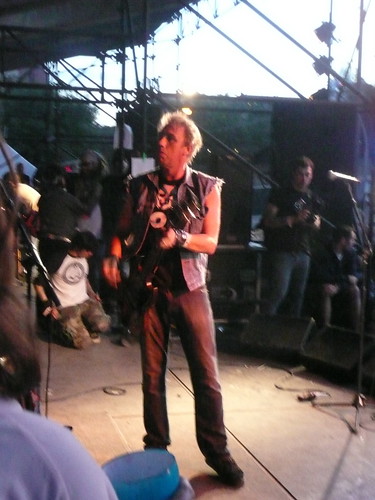
D.O.A. Austin, Texas, 2008, Fun Fun Fun Fest.
From what my doctors had said—and viewed from D.O.A.’s perspective—I’m pretty certain that my chest injuries were caused by repeated exposure to the mosh pit. Or, maybe–if one digs deeper–from my reaction to my musically silent childhood.
Moving on from punk:
Despite my punk past, my taste in music has changed. Right now, I’m all over the indie pop. This is problematic.
As the band Arcade Fire sings on their Grammy-winning album The Suburbs, “Music divides/us into tribes.” My musical tastes are now putting me into a different tribe than my girlfriends, most of whom don’t know what the hell I’m talking anytime when I mention this week’s new favorite band.
My vivid remembrance of the 80s and my nearly underage taste in music are two things that seemed quite clearly demarcated when I went to Fun Fun Fun Fest a couple of years ago.
Fun Fun Fun Fest 2011. The next day was a total dustbowl.
If you live outside of Austin, you might not have even heard of this poor relation to SXSW and the Austin City Limits Music Festival. Fun Fun Fun Fest is a combination of indie pop—the sort of thing played on the Sirius Satellite Radio station XMU and defined by bands like Arcade Fire—and the harder sounds of punk and heavy metal. These sounds are played at different ends of the park during the festival. In some ways, the festival is having my past and my present both simultaneously come to life.
In the fall of 2011, I’d convinced my college friend Dr. Bill Craven to come from San Francisco to Fun Fun Fun Fest. His Twitter bio claims he’s a “recovering physicist on the lam.” He’s a CalTech graduate, and the smartest man I know. Bill’s father was a bomber pilot in WWII, and he spent his formative years in Tokyo. He’s not your typical anyone.
It turned out that apart from Spoon- the band he’d come to FFFFest to see–Bill didn’t know any of the other bands playing the festival. I was slightly surprised to find out that it was Bill’s first music festival, even though he has season tickets to the San Francisco Symphony. So, I became his indie-pop Sherpa, leading him through the festival and making sure he had fun.
Spoon, Fun Fun Fun Fest, 2011.
At one point during FFFFest 2011, Bill and I drifted down from the indie pop end of the festival to the dustier end of the punk stage. I was shocked to find that the punk end of the festival was filled with detritus of what happens when time passes you by. I couldn’t help but notice all of the dudes with gray hair and wallets on a chain. I saw more than one instance of a beer gut straining a vintage concert T-shirt.
The Black Stage, Fun Fun Fun fest 2011.
In what was the worst flaskback, er, flashback of my life, I saw denim jackets sporting the patches of bands that hadn’t been together for decades. I saw a lot of people who looked like their wrinkly selves had been dropped into the clothing that they’d saved since 1989. It wasn’t pretty. It was like running into an old boyfriend that you used to be crazy about, and wondering what you ever saw in him. Bill and I quickly fled for the indie pop end of the park, where people weren’t such fossilized caricatures of their younger selves.
During most of that festival, Bill and I hung around the main stage, which was filled with gentle-ish indie pop. I thought that if I was introducing him to newer bands, that it would be best to show him the sweetest side of indie pop. He saw the San Francisco based Girls, the tiny and dramatic Swedish singer Lyike Li and the Toronto-based band Austra. During Passion Pit I suspect I was the oldest person regularly squealing, “oooh, I love this song!”
Swedish singer Lyike Li, Fun Fun Fun Fest 2011.
Again and again, Bill–wearing his tight, Swedish-made hipster trousers–compared these new indie-pop bands we were seeing at Fun Fun Fun Fest to their ‘70s and ‘80s equivalents. Bill drew parallels between Passion Pit, Girls and Austra, to the Bee Gees, Fleetwood Mac, ABBA and 50’s novelty singer Yma Sumac. Given my musically stunted childhood, these aren’t comparisons I made on my own.

M83, Fun Fun Fun Fest 2011.
Bill said it was okay that he didn’t see these current artists doing anything new, because the kids today hadn’t necessarily heard the classics that he’d grown up on. At that moment, I felt a cartoon-style bubble popping out over my head while sitting on the dead grass of the festival grounds.
Austra, Fun Fun Fun Fest 2011.
I realized that growing up with mostly gospel music, I hadn’t really heard these classic rock bands either. These sounds were new to people who had missed the 70s, but they were also new to me. I realized that maybe my attraction to this indie pop was that I was having either a second (musical) childhood or a delayed musical adolescence, since I’d missed it all the first time.
Of course having mostly missed the mainstream 70’s and 80’s music doesn’t mean I missed everything else that happened during the Reagan era.
I could tell that most of the people who filled up Fun Fun Fun Fest when Bill and I were there hadn’t had the same influences as me when we visited the vintage cars parked in the “El Camino” lounge in the middle of the festival. The automotive attractions included: a Ford Pinto that was a lot like the one that my Hank Williams loving grandfather used to drive, to an El Camino that might well have been the same vehicle that regularly held down the pavement in my high school’s parking lot. These cars were a spin down my automotive past, but unlike many others at the festival, I felt no need to pose for pictures in a Pinto.
That first personal epiphany at Fun Fun Fun Fest was followed by a second, minor epiphany.
Reading the Fun Fun Fun Fest coverage in the music press that fall, I read how Dan Yemin of the band Paint It Black (who is also a practicing psychologist) had had an onstage chat with the audience about how there were no women in punk, and how we shouldn’t rest until there were women on the punk stages of festivals like Fun Fun Fun Fest.
It’s a testament to my conservative upbringing that, despite the fact that I listened to all of these punk bands in high school and college— and despite being one of the very few women in the audience for a lot of old-school punk bands over the years — I somehow never thought about the fact that punk is filled with dudes, while one very seldom sees women on stage.
I suspect that growing up in Texas—where our collective mania revolves around dudes playing football and women cheering from the sidelines—I never really thought about the fact that I was spending a lot of time watching dudes do something. That was just normal.
In my elementary school, the most glamorous woman around was the older sister of a classmate, whose grown up job was a Derrick Doll—the 1980s Houston Oilers equivalent to the Dallas Cowboys Cheerleaders. When one of her wealthy dates came to pick her up in a DeLorean on our working class street, it was very clear that beauty—and big hair—were being rewarded. In the world I grew up in, women were usually rewarded for being pretty, not for doing anything in the world.
Ritzy Bryan of The Joy Formidable, Fun Fun Fun Fest 2011
Years of repressing these sorts of thoughts may explain why I nearly burst with joy when seeing female-led band The Joy Formidable play Fun Fun Fun Fest. When I first saw Ritzy Bryan at SXSW in 2011, I loved how she took control of the stage with her guitar. Playing for a larger audience for Fun Fun Fun Fest, frontwoman Bryan was a formidable presence, taking no prisoners. She’s no Derrick Doll cheering for someone else.
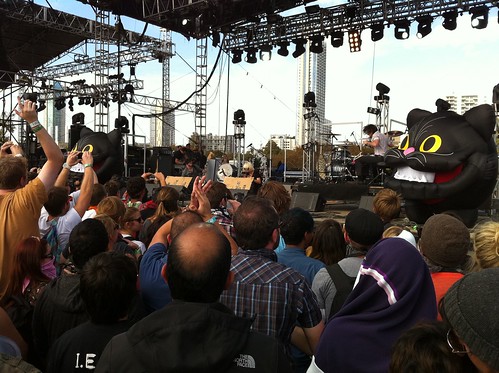
Giant cats at The Joy Formidable, Fun Fun Fun Fest 2011
Earlier this spring as I was watching the SXSW World Premiere of the film The Punk Singer about Bikini Kill frontwoman and “riot grrl” Kathleen Hanna, I was so impressed with what she had done, as I had only been vaguely aware of her music in the early 90s.
While I was still thinking a great deal about the personal epiphanies I’d had during and after the last time I went to Fun Fun Fun Fest, I saw the band Wilco tape an episode of the TV show Austin City Limits. Looking out over the auditorium and hearing Jeff Tweedy sing about “the bible black pre-dawn” and how he was “born to die” I couldn’t help thinking of all of those Sundays spent on the hard and slippery pews of the Baptist church.
Looking down across the auditorium at that Wilco taping, I could just see the back of my tall pal Matt Shiverdecker’s distinctive head.
“This is my church” Shiverdecker had once quipped, airing his frustration on Twitter at the people who talk mindlessly through indie rock shows. That quip stuck with me.
I couldn’t help but wonder while listening to Tweedy sing that –given my ultra religious, old-school upbringing—maybe I’d just changed churches.
If you happen to see me at a show, I’ll likely be the one who looks like she is having a religious experience. Except I’ll have a drink in my hand, instead of a bible, and—God willing– I’ll be very happily worshipping at the church of my choice.
